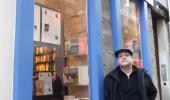Sunday, July 28, 2024 - 8:22am
Bach Choir to give sound to silent 'Phantom'
The Man of a Thousand Faces is best remembered for one that was hidden beneath a mask -- the one worn by "The Phantom of the Opera."
Lon Chaney was that monstrous title character in Rupert Julian's 1925 silent film rendering, and he's baaack, as part of the Three Rivers Film Festival this weekend, for two extraordinary performances that are musically, not digitally, enhanced in a phenomenal collaboration with the Bach Choir of Pittsburgh.
The landmark film, based on Gaston Leroux's 1910 novel, opens with a creepy figure in shadow beneath that "sanctuary of song-lovers, the Paris Opera House -- rising nobly over medieval torture chambers long forgotten." Upstairs in the executive suite, the proprietors wink knowingly to each other as they close a deal unloading this old albatross of a theater to new owners: "By the way, you may hear of a ghost ...."
They'll be hearing a lot more of him.
Enter the leading diva's battle-ax mother, brandishing a note from the Phantom to her daughter Carlotta: She's to be replaced (as Marguerite in "Faust") by her winsome understudy Christine -- and Carlotta had better not interfere. Thenceforth, the Phantom is a busy Mephisto, mesmerizing Christine with a Faustian takeover of her heart and career, while making a homicidal nuisance of himself on her behalf.
The histrionic silent-acting style can generate giggles and take a while to adjust to in 2010. But the first close-up of Mary Philbin as Christine -- subtler and more gorgeous than peers like Mary Pickford -- should do it: the erotic thrill and absence of fear in her smile-response to the Master's "I have come for you."
Carlotta bucks the Phantom and brings down the house in the famous chandelier drop scene. While pandemonium reigns above, the Phantom leads his love down to the underground black lagoon and his (rather elegant) bachelor pad, "hidden from man and sun" -- the model for all subsequent film and stage settings, including the 1986 Webber mega-musical and the better but lesser-known one by Maury Yeston and Arthur Kopit.
Speaking of music ...
There was a mighty Wurlitzer in every big 1925 movie house, and a small orchestra or at least a piano player in smaller venues. Revival screenings sometimes employ a synthesizer to replicate the original accompaniment. But the Bach Choir of Pittsburgh and a superb eight-piece orchestra under Thomas Douglas go much further -- and better. Mr. Douglas' typically bold, stretch-the-envelope concept sets the scenes to arias (mostly by Bizet and Gounod) and other French music likely to have been heard at the Paris Opera during the late 19th-century period of the story.
So there they all are at the Regent Square Theater -- the little orchestra down front, the large choir crammed together in back -- a less than ideal space, to be sure, but no hindrance to the production of their powerful sound, thanks to the precision of Mr. Douglas' baton. This whole idea, and deft execution of it, could only have come from him.
First musical gem, properly enough, is the Jewel Song from Act 3 of "Faust" -- an excellent rendering by soprano Kathryn Copeland. Other stand-out soloists included soprano Alexis Parshook, tenor Will Daniel, and basses John Walko and Matthew Dooley. Four amazingly beautiful selections from Bizet's "Pearl Fishers" -- very rarely heard -- are integrated with the on-screen action, the opera's gorgeous Act 2 Finale matching the spectacular watery finale of the film.
I wanted a rumbling bass buildup and big percussive crash for the chandelier's falling, but didn't get it. Mr. Douglas never goes for the obvious. Massenet instrumental interludes from "Werther," for instance, feature a terrific violin-bass duet. But Mr. Douglas' most daring musical choice is a long, eerie Tableau from Poulenc's "Dialogues of the Carmelites," with soloists Rebecca Rumfelt and Gina Purri.
The print contains restored tinted and primitive Technicolor shots, notably an orgiastic masked ball sequence, and full footage of the fab rooftop scene in which the Phantom spies on Christine's betrayal from behind a gargoyle. The chase-climax is a wonder of frantic (and very contemporary-looking) low-angle camera technique.
Sole problem at the opening last Sunday was the excessive wattage of musicians' lights, diluting the image on the screen's right side -- but hopefully fixed for the Saturday and Sunday shows.
This "Phantom" is alive and well at 85 -- a stunningly original experience, a film and truly a concert as well, requiring an enormous amount of creative integration and coordination. Get your tix and find your seats early (it's a small theater), if you don't want to be in SRO space with the choir.
But I can't help thinking that, as great as the music is, Chaney is greater -- acting with the huge handicap of a mask that covers not just his eyes and nose but mouth, too. The oddly sad-gentle expression on the mask reminds me of his near-neighbor -- Chaney's previous incarnation -- the Hunchback, over at Notre Dame. (Did they ever lunch together?) More poignant than frightening, the Phantom really WANTS to be redeemed by Christine's love. When he carries her down into his subterranean digs and lays her unconscious bod on his boat-shaped bed, his intentions seem so honorable.
Just don't get on his bad side -- and don't touch that mask.






